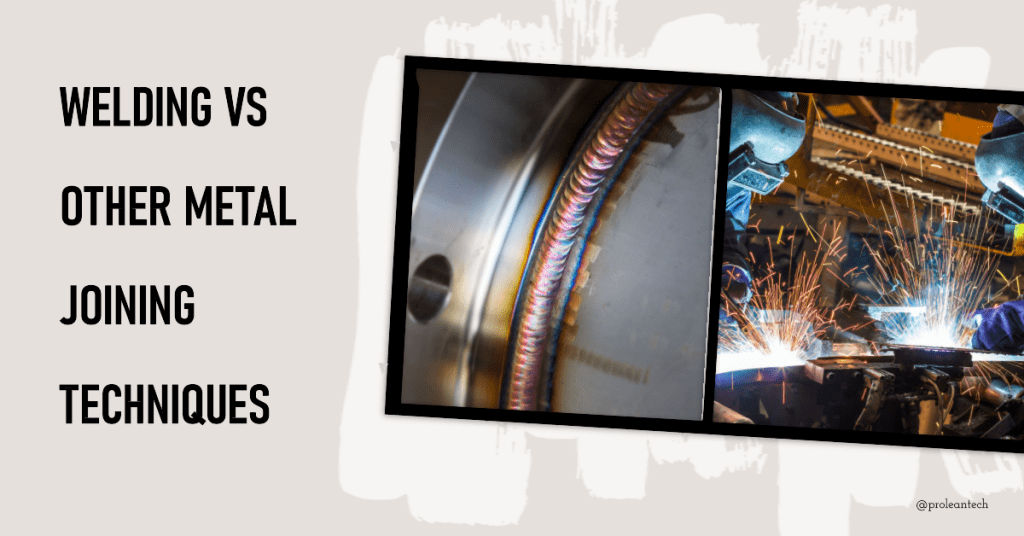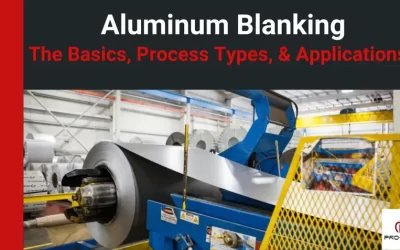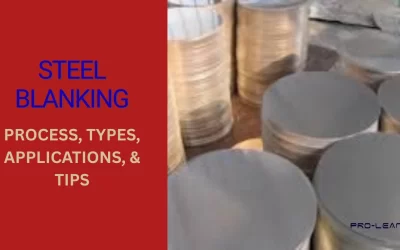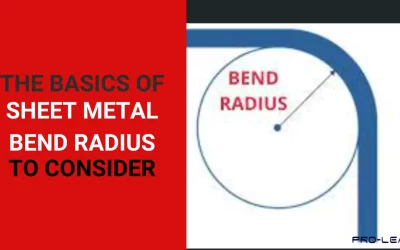
Metal joining is a crucial process in various industries, allowing the creation of complex structures and assemblies. Among the different metal joining techniques, metal welding stands out as one of the most widely used methods. However, there are alternative techniques available that offer unique benefits and are suitable for specific applications.
In this comprehensive comparison, we will explore welding and other metal joining techniques, discussing their differences, advantages, limitations, and applications.
Welding: The Cornerstone of Metal Joining
Welding is a metal joining process that involves the fusion of two or more pieces of metal to create a permanent joint. It utilizes heat, pressure, or a combination of both to melt the base materials and a filler metal (if necessary) to form a solid joint upon cooling. Learn more about welding type.
Advantages & Limitations of Welding
| Advantages of Welding | Limitations of Welding |
|---|---|
| Welded joints offer high strength and durability, ensuring long-lasting connections in various applications. | Welding requires specialized skills and knowledge to achieve quality welds, necessitating trained professionals. |
| Welding can be applied to a wide range of materials, including steel, aluminum, stainless steel, and more. | The heat generated during welding can affect the properties of the base material in the vicinity of the weld, potentially leading to distortion or changes in mechanical properties. |
| Welding allows for the creation of complex structures and assemblies, accommodating unique design requirements. | Welding may be challenging or impractical for joints located in confined or hard-to-reach areas. |
| Welding can be a fast and efficient process, enabling the rapid fabrication of large structures and assemblies. | Welding may not be suitable for dissimilar materials or combinations that are prone to metallurgical incompatibilities. |
| In many cases, welding is a cost-effective method for joining metals, reducing the need for additional fasteners or connectors. | Welding often requires specific equipment, such as welding machines, shielding gases, and safety gear, which may involve additional setup and cost. |
Related to: CNC Materials Mastery: Exploring the Wide Range of Machinable Options for CNC Machines
Applications of Welding
- Construction and Infrastructure: Welding is extensively used in the construction industry for the fabrication of buildings, bridges, pipelines, and structural components.
- Automotive and Aerospace: Welding plays a vital role in the manufacturing of vehicles, including cars, trucks, aircraft, and spacecraft.
- Manufacturing and Fabrication: Welding is employed in various manufacturing sectors, such as metal fabrication, machinery production, and consumer goods manufacturing.
- Oil and Gas Industry: Welding is critical for the fabrication and maintenance of pipelines, storage tanks, and offshore structures in the oil and gas industry.
.
Other Metal Joining Techniques: Exploring Alternatives
While welding is a commonly used metal joining technique, there are several other methods available that offer unique advantages in specific applications. Here are some alternative metal joining techniques to consider:
Mechanical Fastening
Mechanical fastening involves joining metal components using mechanical devices such as screws, bolts, nuts, rivets, or clips. It offers several benefits, including ease of disassembly, cost-effectiveness, and suitability for joining dissimilar materials. Some common mechanical fastening methods include:
- Bolted joints
- Screwed joints
- Riveted joints
Adhesive Bonding
Adhesive bonding utilizes specialized adhesives to bond metal components together. It provides excellent strength, vibration damping, and corrosion resistance. Adhesive bonding is particularly useful for joining dissimilar materials and creating lightweight structures. Key advantages of adhesive bonding include:
- Uniform distribution of stress
- Enhanced design flexibility
- Elimination of heat-affected zones
- Improved fatigue resistance
Brazing
Brazing involves joining metal components using a filler material that melts at a higher temperature than the base metals but lower than their melting points. The filler material is drawn into the joint by capillary action, creating a strong bond. Brazing offers advantages such as:
- Compatibility with various metals and alloys
- High joint strength
- Heat dissipation across the joint
- Improved corrosion resistance
Soldering
Soldering is a low-temperature metal joining technique that utilizes a filler material called solder. It is commonly used for electronics and plumbing applications. Soldering offers benefits such as:
- Low heat input, minimizing distortion
- Ability to join delicate and small components
- Electrical conductivity of solder joints
- Cost-effectiveness
Clinching
Clinching involves joining metal components through cold deformation. It does not require heat or additional materials. Instead, it uses specialized tools to deform and interlock the metal sheets, creating a strong mechanical connection. Clinching offers advantages including:
- The fast and efficient joining process
- No additional consumables required
- Suitable for lightweight materials
- Good resistance to vibration and dynamic loads
Try Prolean Now!
Comparison Table: Welding Vs Other Methods
Here’s a detailed comparison table that compares welding with other metal joining methods based on various aspects.
| Aspect | Welding | Mechanical Fastening | Adhesive Bonding | Brazing | Soldering | Clinching |
|---|---|---|---|---|---|---|
| Joining Process | Fusion of base metals | Mechanical fasteners | Adhesive bonding | Filler material melts and flows | Filler material melts and flows | Cold deformation and interlocking of metal sheets |
| Heat Input | High | Low | Low | Moderate | Low | None |
| Joint Strength | High | Depends on the fastener type | High | High | Moderate | High |
| Joint Integrity | Excellent | Dependent on fastener quality | Excellent | Excellent | Good | Excellent |
| Joint Flexibility | Limited (brittle materials) | Limited (rigid connections) | Excellent | Limited (rigid connections) | Good | Excellent |
| Joint Aesthetics | Visible weld bead | Visible fasteners | Virtually invisible | Visible filler material | Virtually invisible | Visible interlocking marks |
| Joint Thickness | Can accommodate thick sections | Depends on the fastener size | Can accommodate thick sections | Can accommodate thick sections | Limited to thin sections | Can accommodate thin sections |
| Material Compatibility | Versatile | Limited to compatible fasteners | Versatile | Limited to compatible filler metals | Limited to compatible solder alloys | Limited to compatible materials |
| Cost | Moderate to high | Low | Moderate to high | Moderate to high | Low | Low |
| Production Efficiency | Time-consuming | Fast | Time-consuming | Time-consuming | Fast | Fast |
| Disassembly | Difficult | Easy | Difficult | Difficult | Difficult | Difficult |
| Environmental Impact | Can produce fumes and slag | Minimal | Minimal | Minimal | Minimal | Minimal |
Please note that this table provides a general comparison and that the suitability of each joining method may vary depending on specific applications and requirements. It’s important to consider factors such as material compatibility, joint strength, production efficiency, and cost when choosing the appropriate metal joining method for a particular project.
Conclusion
In conclusion, the choice between welding and other metal joining techniques depends on various factors such as application requirements, material compatibility, joint strength, accessibility, and design considerations. Welding is a versatile and widely used method that offers excellent strength and durability, while alternative techniques like mechanical fastening, adhesive bonding, brazing, and soldering provide unique advantages in specific situations. By understanding the differences and limitations of each method, you can make informed decisions about selecting the appropriate welding services or sheet metal services for your metal joining needs.
Prolean offers a wide range of welding services for various applications. Their skilled team of welders and advanced equipment can handle diverse projects, ensuring high-quality and precise welding for industries such as automotive, aerospace, manufacturing, and more. Contact Us Today!
FAQ’s
Is welding the strongest metal joining method?
Welding provides high joint strength, but other methods like brazing and adhesive bonding can also offer strong joints depending on the application.
Can adhesive bonding replace welding?
Adhesive bonding can be a viable alternative to welding in certain applications, offering advantages such as weight reduction, stress distribution, and improved aesthetics.
Are mechanical fasteners more cost-effective than welding?
Mechanical fasteners can be more cost-effective than welding in terms of initial investment, but long-term costs depend on factors like maintenance and disassembly requirements.
Is soldering suitable for heavy-duty applications?
Soldering is typically used for lighter applications and electronics, as it involves lower temperatures and weaker joints compared to welding or brazing.




0 Comments